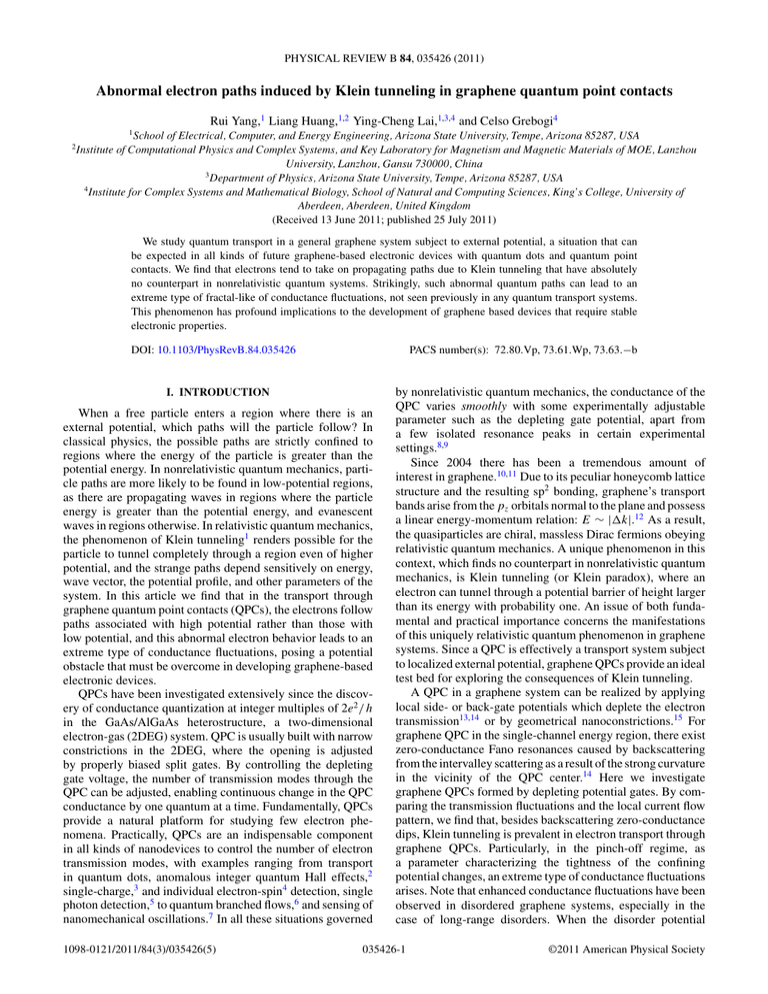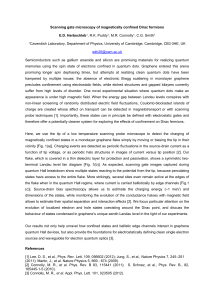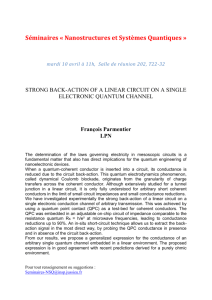Abnormal electron paths induced by Klein
advertisement

PHYSICAL REVIEW B 84, 035426 (2011) Abnormal electron paths induced by Klein tunneling in graphene quantum point contacts Rui Yang,1 Liang Huang,1,2 Ying-Cheng Lai,1,3,4 and Celso Grebogi4 1 2 School of Electrical, Computer, and Energy Engineering, Arizona State University, Tempe, Arizona 85287, USA Institute of Computational Physics and Complex Systems, and Key Laboratory for Magnetism and Magnetic Materials of MOE, Lanzhou University, Lanzhou, Gansu 730000, China 3 Department of Physics, Arizona State University, Tempe, Arizona 85287, USA 4 Institute for Complex Systems and Mathematical Biology, School of Natural and Computing Sciences, King’s College, University of Aberdeen, Aberdeen, United Kingdom (Received 13 June 2011; published 25 July 2011) We study quantum transport in a general graphene system subject to external potential, a situation that can be expected in all kinds of future graphene-based electronic devices with quantum dots and quantum point contacts. We find that electrons tend to take on propagating paths due to Klein tunneling that have absolutely no counterpart in nonrelativistic quantum systems. Strikingly, such abnormal quantum paths can lead to an extreme type of fractal-like of conductance fluctuations, not seen previously in any quantum transport systems. This phenomenon has profound implications to the development of graphene based devices that require stable electronic properties. DOI: 10.1103/PhysRevB.84.035426 PACS number(s): 72.80.Vp, 73.61.Wp, 73.63.−b I. INTRODUCTION When a free particle enters a region where there is an external potential, which paths will the particle follow? In classical physics, the possible paths are strictly confined to regions where the energy of the particle is greater than the potential energy. In nonrelativistic quantum mechanics, particle paths are more likely to be found in low-potential regions, as there are propagating waves in regions where the particle energy is greater than the potential energy, and evanescent waves in regions otherwise. In relativistic quantum mechanics, the phenomenon of Klein tunneling1 renders possible for the particle to tunnel completely through a region even of higher potential, and the strange paths depend sensitively on energy, wave vector, the potential profile, and other parameters of the system. In this article we find that in the transport through graphene quantum point contacts (QPCs), the electrons follow paths associated with high potential rather than those with low potential, and this abnormal electron behavior leads to an extreme type of conductance fluctuations, posing a potential obstacle that must be overcome in developing graphene-based electronic devices. QPCs have been investigated extensively since the discovery of conductance quantization at integer multiples of 2e2 / h in the GaAs/AlGaAs heterostructure, a two-dimensional electron-gas (2DEG) system. QPC is usually built with narrow constrictions in the 2DEG, where the opening is adjusted by properly biased split gates. By controlling the depleting gate voltage, the number of transmission modes through the QPC can be adjusted, enabling continuous change in the QPC conductance by one quantum at a time. Fundamentally, QPCs provide a natural platform for studying few electron phenomena. Practically, QPCs are an indispensable component in all kinds of nanodevices to control the number of electron transmission modes, with examples ranging from transport in quantum dots, anomalous integer quantum Hall effects,2 single-charge,3 and individual electron-spin4 detection, single photon detection,5 to quantum branched flows,6 and sensing of nanomechanical oscillations.7 In all these situations governed 1098-0121/2011/84(3)/035426(5) by nonrelativistic quantum mechanics, the conductance of the QPC varies smoothly with some experimentally adjustable parameter such as the depleting gate potential, apart from a few isolated resonance peaks in certain experimental settings.8,9 Since 2004 there has been a tremendous amount of interest in graphene.10,11 Due to its peculiar honeycomb lattice structure and the resulting sp2 bonding, graphene’s transport bands arise from the pz orbitals normal to the plane and possess a linear energy-momentum relation: E ∼ |k|.12 As a result, the quasiparticles are chiral, massless Dirac fermions obeying relativistic quantum mechanics. A unique phenomenon in this context, which finds no counterpart in nonrelativistic quantum mechanics, is Klein tunneling (or Klein paradox), where an electron can tunnel through a potential barrier of height larger than its energy with probability one. An issue of both fundamental and practical importance concerns the manifestations of this uniquely relativistic quantum phenomenon in graphene systems. Since a QPC is effectively a transport system subject to localized external potential, graphene QPCs provide an ideal test bed for exploring the consequences of Klein tunneling. A QPC in a graphene system can be realized by applying local side- or back-gate potentials which deplete the electron transmission13,14 or by geometrical nanoconstrictions.15 For graphene QPC in the single-channel energy region, there exist zero-conductance Fano resonances caused by backscattering from the intervalley scattering as a result of the strong curvature in the vicinity of the QPC center.14 Here we investigate graphene QPCs formed by depleting potential gates. By comparing the transmission fluctuations and the local current flow pattern, we find that, besides backscattering zero-conductance dips, Klein tunneling is prevalent in electron transport through graphene QPCs. Particularly, in the pinch-off regime, as a parameter characterizing the tightness of the confining potential changes, an extreme type of conductance fluctuations arises. Note that enhanced conductance fluctuations have been observed in disordered graphene systems, especially in the case of long-range disorders. When the disorder potential 035426-1 ©2011 American Physical Society YANG, HUANG, LAI, AND GREBOGI PHYSICAL REVIEW B 84, 035426 (2011) varies on the atomic scale, due to the intervalley scattering the conductance fluctuations are suppressed.16 II. THE QPC MODEL AND NUMERICAL METHODS A QPC can be modeled by an external potential applied to the nanoribbon, where the “tightness” of the potential determines the degree of the confinement. A prototypical form of the potential is6 V (x,y) = W exp (−x /ξ ) · y , 2 2 2 depleting potential. The retarded (advanced) Green’s function of the QPC is given by −1 r(a) (E) , Gr(a) (E) = E · I − H − Sr(a) (E) − D r(a) (E) is the retarded (advanced) self-energy due to where S(D) the source (drain) of the QPC, and the coupling matrices are r a S(D) (E) = i S(D) (E) − S(D) (E) . The transmission is given by T (E) = Tr[S (E)Gr (E)D (E)Ga (E)], (1) where x and y denote the parallel and lateral directions of the ribbon, respectively. We choose ξ = 10a, a being the lattice constant (a = 2.46 Å for graphene), and the parameter W characterizes the “tightness” of the potential. By adjusting W , the total number of transmission modes through the QPC can be controlled. The reasonable range to vary W is between zero and t, where t is the nearest-neighbor hopping energy. To calculate the electron flow paths and the conductance of graphene QPC, we resort to the tight-binding framework. The Hamiltonian is Ĥ = −t |ij | + V (xi ,yi )|ii|, and the conductance is obtained via the Landauer-Büttiker formula.17 The local current per unit energy at the Fermi energy between two neighboring sites i and j can be calculated by 4e Im Hij Cjni (E) , (2) h where Cn = Gr S Ga is the electron correlation function and Hij is the corresponding matrix element in the tight-binding Hamiltonian.17 Ji→j (E) = III. RESULTS AND DISCUSSION A. Abnormal electron paths i where the first summation is over all pairs of nearestneighboring atoms, and the second term describes the Figure 1 shows typical electron flow patterns through a graphene QPC as W is increased (left column, from top to bottom). For comparison, we have included the corresponding FIG. 1. (Color online) Electron flow (x-component) patterns through graphene (left column) and nonrelativistic (right column) QPC for different values of the parameter W . In each panel the current flow is normalized by the maximum value Jmax through the QPC. The conductance (in unit of 2e2 / h), W/t and Jmax are (a) 3.2464, 0.05, 0.8638; (b) 3.0107, 0.02, 0.2505; (c) 1.0172, 0.26, 0.6872; (d) 1.0113, 0.16, 0.2645; (e) 0.0281, 0.64, 0.0049; and (f) 0.0111, 1, 0.0006, respectively. The Fermi energy for all cases is the same: EF /t = 0.8. The crosses in the left panels indicate the regions where V ∼ 2EF . 035426-2 ABNORMAL ELECTRON PATHS INDUCED BY KLEIN . . . PHYSICAL REVIEW B 84, 035426 (2011) flow patterns for a nonrelativistic QPC (e.g., square lattice structure for conventional semiconductor quantum dots) of the same geometry (right column). For the nonrelativistic QPC, the transport tends to occur mostly in the region where the potential is minimum, and the electron flow pattern is smooth.6 However, for the graphene QPC, the transport appears highly nonuniform. Surprisingly, for some values of W the electrons tend to move along paths with higher local potentials. A careful examination of the electron flows reveals that, in such a case, the most favorable path has the potential energy that is approximately twice of the Fermi energy, as indicated by the paths marked by the crosses in the left column of Fig. 1. This finding strongly suggests Klein tunneling as a plausible mechanism for the observed highly localized electron flow paths in the graphene QPC. The phenomenon is persistent for various choices of the parameters W and ξ in the model (1). Why do quasiparticles in the graphene choose the particular Klein-tunneling path to travel through the QPC? A more general question is what paths do quasiparticles take in a graphene system consisting of regions under different external potentials? In nonrelativistic quantum mechanics, particles can tunnel through a potential barrier but the transmission probability decreases exponentially with the height and/or width of the barrier. However, when a relativistic quantum particle approaches a potential barrier, situations can occur where, for example, as the height of the barrier is increased, the transmission probability can reach unity (corresponding to zero reflection)—the Klein paradox.1 The occurrence of Klein tunneling depends on a number of parameters in the system, such as the height and the width of the potential barrier and the incident angle of the particle. For a rectangular potential barrier, the dependence of the transmission probability on parameters can be obtained analytically.18–20 In the graphene QPC system, when a relativistic quasiparticle approaches the potential region, it may not follow the path corresponding the minimal potential but can instead choose a path with higher potential to pass through the QPC via the mechanism of Klein tunneling. To gain insight, we consider a simplified model of a square potential barrier on a graphene ribbon, as shown in Fig. 2. For fixed Fermi energy, the variation of the conductance versus the potential height V is shown in Fig. 3. The results can be understood by considering the number of transmitting modes NT in the potential region: As the potential V is increased from 0, it squeezes out the electrons and there are fewer transmission modes, leading to decreased conductance. The conductance reaches minimum at V ∼ EF as NT is small. Due to the conical spectrum of graphene, after crossing the Dirac point, NT (now for the holes) increase again until V ∼ 2EF , where values of NT inside (holes) and outside (electrons) the potential are equal and the conductance reaches the maximum due to Klein tunneling. As V is increased further, the conductance tends to approximately constant values since NT inside the potential region is still larger. To further illustrate the peculiar electron flow pattern in graphene QPC and its consequences on transport, we plot the local current flow in the graphene lattice on top of the surface FIG. 2. (Color online) (a) Illustration of Klein tunneling of graphene quasiparticles. (b) Simplified potential profile, a square potential barrier of height V along the direction of the ribbon. of the confinement potential in Fig. 4. The current is uniformly distributed in the y direction far from the QPC. As it approaches the QPC region, it is squeezed to the middle by the confinement potential. Then, as the current flows into the central region of the QPC, it diminishes in its original x direction and diverges to the sides: the current flows up the potential hill and reaches the region V ∼ 2EF .20,21 Then it flows on the path of V ∼ 2EF . As it reaches the boundary of the drain of the QPC, it flows down the potential hill toward the middle valley, and continues into the drain. The electrons thus choose not to go through the region where the potential is minimum, but instead follow the paths in regions of higher potential, as stipulated by Klein tunneling. This uniquely relativistic quantum behavior is determined by the chiralities of the quasiparticles.19 100 E /t=0.8 f 90 E /t=0.5 80 Ef/t=0.3 f 70 2 G (2e /h) B. The mechanism — Klein tunneling 60 50 40 30 20 10 0 0 0.5 1 1.5 2 2.5 3 3.5 4 V/t FIG. 3. (Color online) Conductance G versus applied rectangular potential height V for the graphene nanoribbon under different Fermi energy EF /t = 0.8, 0.5, and 0.3. The width of the ribbon is 138a so the a maximum number of allowed transmission modes is Nmode = 160, where a is the lattice constant. The size of the potential region is 20a. 035426-3 YANG, HUANG, LAI, AND GREBOGI PHYSICAL REVIEW B 84, 035426 (2011) Drain G (2e2/h) 10 Source 10 10 10 y x 10 0 0.1 0.2 0.3 0.4 0.5 0.6 0.7 0.8 0.9 1 W/t FIG. 4. (Color online) A direct demonstration of Klein tunneling in graphene QPC: three-dimensional view of current flow with respect to the potential profile of the QPC. The sizes of the arrows indicate the values of the current flow. The Fermi energy is EF = 0.8. Inset: solid line is the fractal-like conductance fluctuations of the graphene QPC as a result of Klein tunneling; dashed line is the smooth conductance variation in the corresponding nonrelativistic QPC. C. Fractal-like conductance fluctuations Note that, due to the sensitive dependence of Klein tunneling on a number of physical factors, the matching condition between the V ∼ 2EF and V ∼ 0 regions to form a steady flow depends sensitively on the energy and externalpotential parameters in various devices.19,20 As a consequence, a small change in the potential parameter [Eq. (1)] has a finite probability to open up a channel for the tunneling, leading to a sudden increase in the conductance. Overall, as the potential parameter changes, the QPC conductance exhibits extremely wild, fractal-like fluctuations, as shown in the inset of Fig. 4. To contrast, we have also calculated the QPC conductance but for a conventional semiconductor 2DEG system subject to the same depleting-gate potential, as shown by the dashed smooth curve in the inset of Fig. 4. Magnifications of some portion of the fluctuation pattern in the inset of Fig. 4 reveal qualitatively the same behavior, indicating fractal-like characteristics. To demonstrate that the fluctuations indeed occur on a hierarchy of scales and to quantify the fractal-like fluctuation pattern, we use the uncertainty algorithm.22 Specifically, we first set a small perturbation ε to the parameter W and calculate the conductances at W and W + ε. If |G(W + ) − G(W )| > δ, where δ is a proper threshold, this value of W is referred to as ε-uncertain as the perturbation can lead to a significantly different value of transmission. For a large number of randomly chosen parameter values, we determine the fraction f (ε) of the uncertain parameter values. If strong fluctuations in the transmission occur across many scales, the fraction f (ε) scales with ε as f (ε) ∼ εα , where 0 α 1 is the uncertainty exponent.22 For the fluctuation pattern in the inset of Fig. 4, we observe that the algebraic scaling of f (ε) extends over two orders of magnitude and the uncertainty exponent is α ≈ 0.16, suggesting the existence of fractal-like fluctuations in the transmission of QPC over a hierarchy of scales.23 In previous studies of fractal conductance fluctuations, the phenomenon generally originates from the heterogeneous dynamical structures of the quantum ballistic cavities,24 while the fractal-like fluctuations reported here are mainly due to the sensitive dependence of the tunneling path on the control parameters. One implication is that the QPC conductance in graphene-based systems can depend sensitively on the detailed physical and geometric properties of the confinement, which may be undesirable in applications where stable QPC conductances are needed. IV. CONCLUSION In summary, we have investigated transport through graphene QPCs and obtained direct evidence of “strange” electron paths as determined by Klein tunneling in relativistic quantum mechanics. As a consequence, the low-temperature conductance of the graphene QPC exhibits an extreme-type of, fractal like fluctuations. These phenomena find no counterparts in conventional 2DEG systems, and they may have fundamental implications to the stability of future graphene-based electronic devices. A paradigmatic system would consist of a number of quantum dots and QPCs, and control gates are properly biased to effectively open or pinch off the conduction modes. The presence of fractal-like conductance 035426-4 ABNORMAL ELECTRON PATHS INDUCED BY KLEIN . . . PHYSICAL REVIEW B 84, 035426 (2011) fluctuations may pose interesting challenges to the operation of such devices. As an example, integrated graphene devices subject to some kind of external potential would be one such class of systems and it will become a topic of high interest. 1 P. Strange, Relativistic Quantum Mechanics with Applications in Condensed Matter Physics and Atomic Physics (Cambridge University Press, Cambridge, 1998). 2 B. J. van Wees, H. van Houten, C. W. J. Beenakker, J. G. Williamson, L. P. Kouwenhoven, D. van der Marel, and C. T. Foxon, Phys. Rev. Lett. 60, 848 (1988); B. J. van Wees, E. M. M. Willems, C. J. P. M. Harmans, C. W. J. Beenakker, H. van Houten, J. G. Williamson, C. T. Foxon, and J. J. Harris, ibid. 62, 1181 (1989). 3 J. R. Petta, A. C. Johnson, C. M. Marcus, M. P. Hanson, and A. C. Gossard, Phys. Rev. Lett. 93, 186802 (2004). 4 J. M. Elzerman, R. Hanson, L. H. Willems van Beveren, B. Witkamp, L. M. K. Vandersypen, and L. P. Kouwenhoven, Nature (London) 430, 431 (2004). 5 S. Gustavsson, M. Studer, R. Leturcq, T. Ihn, K. Ensslin, D. C. Driscoll, and A. C. Gossard, Phys. Rev. Lett. 99, 206804 (2007). 6 M. A. Topinka, B. J. LeRoy, S. E. J. Shaw, E. J. Heller, R. M. Westervelt, K. D. Maranowski, and A. C. Gossard, Science 289, 2323 (2000); M. A. Topinka, B. J. LeRoy, R. M. Westervelt, S. E. J. Shaw, R. Fleischmann, E. J. Heller, K. D. Maranowskik, and A. C. Gossard, Nature (London) 410, 183 (2001); G. Metalidis and P. Bruno, Phys. Rev. B 72, 235304 (2005). 7 M. Poggio, M. P. Jura, C. L. Degen, M. A. Topinka, H. J. Mamin, D. Goldhaber-Gordon, and D. Rugar, Nature Phys. 4, 635 (2008). 8 T. Morimoto, M. Henmi, R. Naito, K. Tsubaki, N. Aoki, J. P. Bird, and Y. Ochiai, Phys. Rev. Lett. 97, 096801 (2006). 9 C.-S. Wen, J. H. Hsiao, K.-T. Lin, T.-M. Hong, J. C. Chen, T. Ueda, and S. Komiyama, Phys. Rev. B 82, 115416 (2010). 10 K. S. Novoselov, A. K. Geim, S. V. Morozov, D. Jiang, Y. Zhang, S. V. Dubonos, I. V. Grigorieva, and A. A. Firsov, Science 306, 666 (2004); C. Berger, Z. Song, T. Li, X. Li, A. Y. Ogbazghi, R. Feng, Z. Dai, A. N. Marchenkov, E. H. Conrad, P. N. First, and W. A. de Heer, J. Phys. Chem. B 108, 19912 (2004); C. W. J. Beenakker, Rev. Mod. Phys. 80, 1337 (2008); A. H. Castro Neto, F. Guinea, N. M. R. Peres, K. S. Novoselov, and A. K. Geim, ibid. 81, 109 (2009); S. Das Sarma, S. Adam, E. H. Hwang, and E. Rossi, ibid. 83, 407 (2011). 11 L. Huang, Y.-C. Lai, D. K. Ferry, S. M. Goodnick, and R. Akis, Phys. Rev. Lett. 103, 054101 (2009); L. Huang, Y.-C. Lai, and C. Grebogi, Phys. Rev. E 81, 055203(R) (2010); L. Huang, R. Yang, and Y.-C. Lai, Europhys. Lett. 94, 58003 (2011). 12 P. R. Wallace, Phys. Rev. 71, 622 (1947). 13 F. Molitor, J. Güttinger, C. Stampfer, D. Graf, T. Ihn, and K. Ensslin, Phys. Rev. B 76, 245426 (2007); S. Nakaharai, J. R. Williams, and C. M. Marcus, Phys. Rev. Lett. 107, 036602 (2011). ACKNOWLEDGMENTS This work was supported by AFOSR under Grant No. FA9550-09-1-0260 and by ONR under Grant No. N0001408-1-0627. LH was also supported by NSFC under Grant No. 11005053. 14 K. Wakabayashi and M. Sigrist, J. Phys. Soc. Jpn. 77, 113708 (2008). 15 A. Rycerz, J. Tworzydo, and C. W. J. Beenakker, Nature Physics 3, 172 (2007); B. Özyilmaz, P. Jarillo-Herrero, D. Efetov, and P. Kim, Appl. Phys. Lett. 91, 192107 (2007). 16 A. Rycerz, J. Tworzydło, and C. W. J. Beenakker, Europhys. Lett. 79, 57003 (2007); T. Ando, J. Phys. Soc. Jpn. 75, 074716 (2006); J. Wurm, A. Rycerz, İ. Adagideli, M. Wimmer, K. Richter, and H. U. Baranger, Phys. Rev. Lett. 102, 056806 (2009); M. Y. Kharitonov and K. B. Efetov, Phys. Rev. B 78, 033404 (2008); D. W. Horsella, A. K. Savchenkoa, F. V. Tikhonenkoa, K. Kechedzhi, I. V. Lerner, and V. I. Fal’ko, Solid State Commun. 149, 1041 (2009); R. Yang, L. Huang, Y.-C. Lai, and C. Grebogi, Europhys. Lett. 94, 40004 (2011). 17 S. Datta, Electronic Transport in Mesoscopic Systems (Cambridge University Press, Cambridge, 1995). 18 C. W. J. Beenakker, Phys. Rev. Lett. 97, 067007 (2006). 19 M. I. Katsnelson, K. S. Novoselov, and A. K. Geim, Nat. Phys. 2, 620 (2006). 20 M. Ramezani Masir, P. Vasilopoulos, and F. M. Peeters, Phys. Rev. B 82, 115417 (2010). 21 There are two favorable paths for electrons (Fig. 3): one for V ∼ 0 and another for V ∼ 2EF . In this case, the path for V ∼ 0 is squeezed out, while the one for V ∼ 2EF is still open. For small values of W , the path for V ∼ 0 can also be open, as shown in Fig. 1(a). 22 C. Grebogi, S. W. McDonald, E. Ott, and J. A. Yorke, Phys. Lett. A 99, 415 (1983). 23 In nonlinear dynamics, the dimension D of a fractal set can be related to the uncertainty exponent by D = 1 − α.22 However, for our QPC system, the transmission fluctuations cannot occur on arbitrarily small scales. Thus the strong fluctuation pattern in the inset of Fig. 4 does not imply the existence of a fractal set. For this reason we use the term “fractal-like” to describe the transmission fluctuation patterns. 24 R. Blümel and U. Smilansky, Phys. Rev. Lett. 60, 477 (1988); R. A. Jalabert, H. U. Baranger, and A. D. Stone, ibid. 65, 2442 (1990); Y.-C. Lai, R. Blümel, E. Ott, and C. Grebogi, ibid. 68, 3491 (1992); R. Ketzmerick, Phys. Rev. B 54, 10841 (1996); A. S. Sachrajda, R. Ketzmerick, C. Gould, Y. Feng, P. J. Kelly, A. Delage, and Z. Wasilewski, Phys. Rev. Lett. 80, 1948 (1998); B. Huckestein, R. Ketzmerick, and C. H. Lewenkopf, ibid. 84, 5504 (2000). 035426-5





